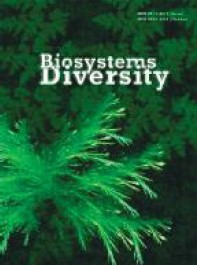Polyphyly of the genus Stenurella (Coleoptera, Cerambycidae): Consensus of morphological and molecular data
Polyphyly of the genus Stenurella (Coleoptera, Cerambycidae): Consensus of morphological and molecular data
Author(s): A. M. Zamoroka, S. Trócoli, V.Y. Shparyk, D.V. SemaniukSubject(s): Environmental Geography
Published by: Дніпропетровський національний університет імені Олеся Гончара
Keywords: longhorn beetles; morphometry; multigene analysis; phylogeny; new taxa; new combinations; new synonymy;
Summary/Abstract: Stenurella genus is represented by nine small-sized and widely distributed Palaearctic species. Representatives of the genus play a key role in the pollination of wild angiosperms, accelerate the detritus cycle and make a significant contribution to the forest food web. A number of species with heterogeneous morphological features found within the single Stenurella genus indicate the need for revision of the taxonomy this genus. The previous attempt to resolve the intrageneric composition of Stenurella was rather artificial because it did not take into an account evolutionary relationships. In this study we tested the existing model of Stenurella intrageneric subdivision using both morphological and molecular approaches. Our results showed that the genus Stenurella is polyphyletic and consists of two unrelated clades. The first clade comprises six species (S. jaegeri, S. novercalis, S. bifasciata, S. melanura, S. hybridula and S. approximans) and the second includes three species (S. septempunctata, S. vaucheri and S. nigra). Moreover, we found that the second clade is closely related to Rutpela due to both morphological and molecular phylogeny. Based on our findings, we revised the present structure of the genus Stenurella and transferred three species of the second clade to the genus Rutpela, sensu novo. The genus Rutpela was redescribed in the light of our results. Furthermore, we subdivided the genus Stenurella, sensu nov. into two subgenera, Stenurella, subgen. sensu nov. and Priscostenurella, subgen. sensu nov., respectively. Also, the genus Rutpela, sensu nov. was subdivided into four subgenera including Nigrostenurella, Rutpela, Eduardvivesia, subgen. nov. and Nigromacularia, subgen. nov. The assessment of the place of Stenurella, sensu novo and Rutpela, sensu novo within Lepturini based on molecular phylogeny, showed that Stenurella, sensu novo belongs to the Anoploderabranch and Rutpela, sensu novo nested within the Leptura-branch. These together with morphological features confirmed our idea of the evolutionary distinctiveness of Stenurella, sensu novo and Rutpela, sensu novo. We assumed that the general external morphological similarity of Stenurella, sensu novo and Rutpela, sensu novo was the result of convergent evolution, driven by mimetic selection toward imitation of ants or wasps. Finally, our study establishes a natural phylogenetic taxonomy of Stenurella.
Journal: Biosystems Diversity
- Issue Year: 30/2022
- Issue No: 2
- Page Range: 119-136
- Page Count: 18
- Language: English

